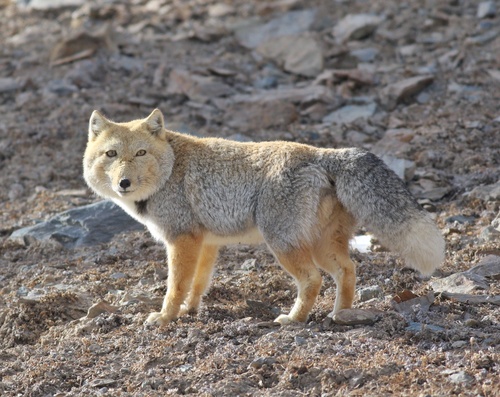
Tibetan Fox
The Tibetan fox, with its unique square face and thick fur, prowls the Tibetan Plateau's high-altitude grasslands. A solitary creature, it masterfully hunts small mammals, playing a vital role in maintaining ecological balance. Adapted to extreme climates, it epitomizes survival amidst harsh conditions.
8-10 years
Lifespan
3.62874 - 5.44311 kg
Weight
Length: 61 - 71 cm
Size
Grey, Tan
Color
1 year
Age of Sexual Maturity
5-9 weeks
Age of Weaning
44 mph
Top Speed
Least Concern
Conservation Status
Unknown
Population Trend
Characteristics
The Tibetan fox, Vulpes ferrilata, inhabits the high-altitude steppes and grasslands of the Tibetan Plateau. It is known for its distinctive square-shaped face and thick fur, which provides insulation against the cold. Primarily a solitary hunter, it preys on small mammals like pikas, contributing to the ecosystem's balance.
Distribution Range of the Tibetan Fox
Vulpes ferrilata, commonly known as the Tibetan fox, is native to the Tibetan Plateau and its surrounding areas. This species is primarily found in the high-altitude regions of Central Asia, including countries such as China (Tibet, Qinghai, Sichuan, and Gansu provinces), Nepal, India (Ladakh region), and Bhutan.
Tibetan Fox's Habitat
Environmental Conditions
The Tibetan fox inhabits cold, arid environments typical of high-altitude plateaus. These areas are characterized by sparse vegetation, rocky terrain, and limited human habitation. The climate is generally harsh, with cold temperatures, strong winds, and low oxygen levels.
Ecological Niche
Vulpes ferrilata is well-adapted to its environment, occupying a niche that involves hunting small prey such as pika, rodents, and ground-nesting birds. Its adaptations include a thick fur coat for insulation against cold temperatures and specialized teeth and jaw structure for catching and consuming its primary prey, the plateau pika.
Copyright @ Nature Style Limited. All Rights Reserved.
 English
English